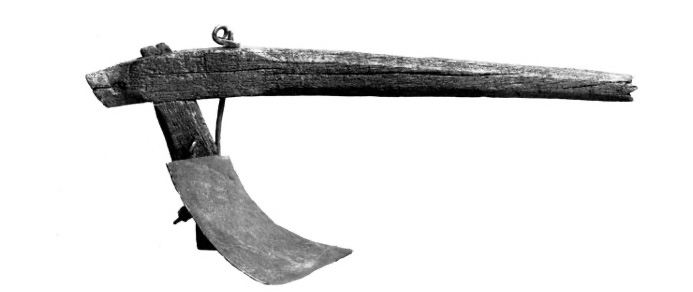1837 Steel Plow Invented

In 1837 John Deere invented the steel plow. This greatly improved the ability of farmers to plow fields.
In 1837, American blacksmith John Deere invented the steel plow, a groundbreaking tool that revolutionized farming in the United States and beyond. At the time, farmers in the Midwest faced significant challenges when trying to cultivate the thick, sticky prairie soil. Traditional cast-iron plows, designed for the sandy and loamy soils of the East Coast, would clog up and require frequent cleaning. This made plowing labor-intensive and inefficient, especially in the dense, clay-rich soils of the expanding frontier. Deere’s invention of a steel plow transformed agricultural practices, making it possible for farmers to work larger fields with less effort, ultimately contributing to the rapid development of American agriculture.
Deere was originally from Vermont and worked as a blacksmith. In the 1830s, he moved to Grand Detour, Illinois, where he quickly recognized the difficulties that farmers were experiencing with existing plows. Observing the local soil conditions and the struggles of local farmers, Deere saw an opportunity to create a new plow that would be better suited to the Midwest’s tough soil. Using his skills as a blacksmith, he fashioned a plow with a polished steel blade. This polished steel design allowed the plow to slice through the soil without soil sticking to the blade, a key improvement over the cast-iron plows.
The steel plow’s design was simple but effective. The polished surface of the steel blade reduced friction as it moved through the soil, allowing it to cut cleanly and without resistance. This made plowing much faster and reduced the physical strain on both farmers and horses. With a steel plow, a farmer could plow more acreage in a day, leading to increased productivity and opening up more land for cultivation. This innovation was particularly valuable as American agriculture expanded westward, where fertile but challenging soil awaited.
The impact of Deere’s steel plow went beyond the immediate efficiency it provided. As word spread of its effectiveness, demand for the new plow increased rapidly, marking the beginning of Deere’s business as a manufacturer of agricultural equipment. By 1843, Deere was producing up to 400 plows a year with the help of local blacksmiths. Recognizing the potential for even greater growth, Deere moved his operations to Moline, Illinois, in 1848, where he established a large-scale manufacturing plant near the Mississippi River. This location allowed him to use river transportation for shipping and receive shipments of raw materials. The factory in Moline became the foundation of Deere’s company, which grew into one of the largest agricultural equipment manufacturers in the world.
Deere’s company continued to refine and expand its product line, introducing innovations in planting, cultivating, and harvesting equipment. The success of the steel plow enabled the rapid expansion of agriculture across the Midwest and Great Plains, areas that became major centers for American farming. Farmers were now able to cultivate crops more efficiently, supporting the country’s growing population and fueling its economy.
Today, Deere & Company, often known simply as John Deere, remains one of the most prominent agricultural equipment manufacturers globally. The steel plow’s legacy is reflected in the company’s enduring impact on farming practices and its role in making agriculture more productive and sustainable. John Deere’s steel plow did more than ease the work of individual farmers; it played a foundational role in transforming American agriculture, symbolizing ingenuity, hard work, and progress. This invention marked a turning point in farming history, setting the stage for the mechanization and modernization of agriculture worldwide.
 >
>